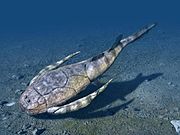| Balanerodus | |
|---|---|
| Scientific classification | |
| Domain: | Eukaryota |
| Kingdom: | Animalia |
| Phylum: | Chordata |
| Class: | Reptilia |
| Clade: | Archosauromorpha |
| Clade: | Archosauriformes |
| Order: | Crocodilia |
| Family: | Alligatoridae |
| Genus: | †Balanerodus Langston, 1965 |
| Type species | |
| †Balanerodus logimus Langston, 1965
| |
Balanerodus is an extinct monospecific genus of alligatorid crocodylian.[1] Fossils have been found from the Fitzcarrald Arch in the Peruvian Amazon and the La Victoria Formation of the Honda Group in Colombia and date back to the Friasian and Laventan regional South American land mammal ages of the Middle Miocene.[2][3]
Description
It was an atypical crocodilian with mysterious acorn-like teeth and co-existed with many other crocodilians, which were more diverse at the time period than they are today, including terrestrial predatory sebecid Langstonia, the massive Purussaurus, and flat headed duck-like Mourasuchus. Its teeth and the diversity of crocodilians suggest it occupied a different niche than they did.[4] Another animal with acorn-like teeth is the Vaquita.[5]
A 2015 study found teeth indistinguishable from those of Balanerodus among a set of Purussaurus teeth, suggesting that the two genera might be synonymous.[6]
References
- ^ Carroll, R.L. 1988. Vertebrate Paleontology and Evolution. WH Freeman and Company, New York ISBN 0-7167-1822-7
- ^ Balanerodus at Fossilworks.org
- ^ Salas-Gismondi, R.; et al. (2007), "Middle Miocene Crocodiles From the Fitzcarrald Arch, Amazonian Peru" (PDF), in Díaz-Martínez, E.; Rábano, I. (eds.), 4th European Meeting on the Palaeontology and Stratigraphy of Latin America, Madrid: Instituto Geológico y Minero de España, pp. 355–360, ISBN 978-84-7840-707-1
- ^ Croft, Darin. Horned Armadillos and Rafting Monkeys. pp. 93–94.
- ^ "Vaquitas". MarineBio Conservation Society. 18 May 2017. Retrieved 8 November 2019.
- ^ Salas-Gismondi, R.; Flynn, J. J.; Baby, P.; Tejada-Lara, J. V.; Wesselingh, F. P.; Antoine, P. O. (2015), "A Miocene hyperdiverse crocodylian community reveals peculiar trophic dynamics in proto-Amazonian mega-wetlands", Proceedings of the Royal Society B: Biological Sciences, 282: 20142490, doi:10.1098/rspb.2014.2490, PMC 4375856, retrieved 2023-12-06






